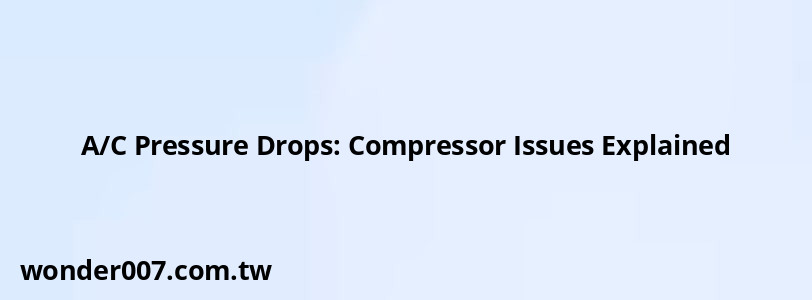A/C Pressure Drops: Compressor Issues Explained

Understanding A/C Pressure Fluctuations
When an air conditioning system experiences a pressure drop as the compressor turns on, it often indicates a problem with the system's refrigerant charge or components. This issue can lead to inadequate cooling and potential damage to the A/C system if left unaddressed.
Normal A/C Operation
In a properly functioning A/C system, the low-side pressure typically ranges from 30 to 40 PSI when the compressor is running. The high-side pressure should be between 150 to 250 PSI, depending on ambient temperature and manufacturer specifications.
Symptoms of Pressure Drop
- Rapid cycling of the compressor (turning on and off frequently)
- Insufficient cooling in the vehicle cabin
- Low-side pressure dropping significantly when the compressor engages
- High-side pressure remaining relatively constant or not rising as expected
Common Causes of Pressure Drop
Low Refrigerant Charge
The most frequent cause of pressure drop when the compressor engages is a low refrigerant charge. This can be due to:
- Small leaks in the system
- Improper previous recharge
- Normal refrigerant loss over time
Faulty Compressor
A failing compressor may not be able to maintain proper pressure, causing:
- Inadequate compression
- Internal leaks
- Reduced pumping capacity
Blocked Expansion Valve or Orifice Tube
These components control refrigerant flow and can cause pressure issues if obstructed:
- Debris or contaminants in the system
- Ice formation due to moisture in the refrigerant
Malfunctioning Pressure Sensors
Faulty pressure sensors can cause the system to misread pressures, leading to:
- Incorrect compressor cycling
- Improper refrigerant flow control
Diagnosing the Issue
To properly diagnose the cause of the pressure drop:
1. Connect a manifold gauge set to the low and high-side service ports
2. Run the A/C system on maximum cooling with high fan speed
3. Observe pressure readings as the compressor engages and disengages
4. Check for visible leaks using UV dye or an electronic leak detector
5. Inspect the compressor for signs of wear or damage
Resolving A/C Pressure Drop Issues
Recharging the System
If low refrigerant is the cause:
1. Locate and repair any leaks
2. Evacuate the system to remove moisture and non-condensables
3. Recharge with the correct amount of refrigerant as specified by the vehicle manufacturer
Compressor Replacement
If the compressor is faulty:
1. Replace the compressor with a new or remanufactured unit
2. Flush the A/C system to remove contaminants
3. Replace the receiver-drier or accumulator
4. Recharge the system with fresh refrigerant and oil
System Component Repair
For other issues:
- Clean or replace the expansion valve or orifice tube
- Check and replace faulty pressure sensors
- Inspect and clean the condenser for proper heat dissipation
Preventive Maintenance
To avoid future A/C pressure issues:
- Regular inspections of A/C components
- Annual system performance checks
- Prompt repair of any detected leaks
- Proper refrigerant charging during service
By understanding the causes and solutions for A/C pressure drops, vehicle owners can ensure their air conditioning systems operate efficiently and effectively, providing optimal comfort in all driving conditions.
FAQs About A/C Pressure Drops
- Can I drive with low A/C pressure?
While possible, it's not recommended as it can damage the compressor and reduce cooling efficiency. - How often should I recharge my A/C system?
A properly sealed system shouldn't need frequent recharging. If you're losing refrigerant, there's likely a leak that needs repair. - What's the cost to fix an A/C pressure issue?
Costs vary widely depending on the cause, from a simple recharge (around $100-$200) to a compressor replacement ($500-$1000+).
Related Posts
-
Key Fob: Troubleshooting Driver Door Unlock Issues
29-01-2025 • 182 views -
High Pressure Fuel Line: 2011 Hyundai Sonata Guide
29-01-2025 • 116 views -
Fuel Tank Pressure Sensor Failures: Common Issues and Solutions
30-01-2025 • 194 views -
2023 Nissan Rogue Dashboard Symbols Explained
26-01-2025 • 196 views -
Chevy 5.3 Vortec Cooling System Diagram Explained
26-01-2025 • 164 views
Latest Posts
-
2015 Chevy Traverse AC Recharge Port Location
01-02-2025 • 366 views -
Are O2 Sensors Covered Under Warranty
01-02-2025 • 339 views -
How To Turn Off Paddle Shifters Mercedes
01-02-2025 • 335 views -
Rear Brake Caliper Piston Won't Compress
01-02-2025 • 315 views -
Power Steering Fluid Leak On Passenger Side
01-02-2025 • 420 views
Popular Posts
-
EPC Light: Understanding Causes and Solutions
26-01-2025 • 1019 views -
Hino Warning Lights: Understanding Dashboard Alerts
26-01-2025 • 636 views -
Power Steering and ABS Light On: Causes and Solutions
27-01-2025 • 613 views -
V12 Engine Costs: What You Need to Know
26-01-2025 • 633 views -
EPC Warning Light: What It Means for Your Vehicle
27-01-2025 • 592 views
